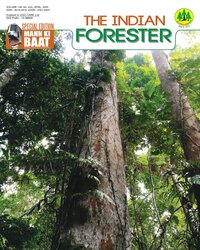Securing Zero Black Liquor Discharge in Pulp and Paper Industries of River Ganga Basin through Participatory Approach
DOI:
https://doi.org/10.36808/if/2023/v149i4(A)/169903Keywords:
Pulp and Paper, Black Liquor, Water Pollution, Chemical Recovery, Mann Ki Baat, Action Plan.Abstract
The pulp and paper industry has been considered a large consumer of freshwater and one of the largest sources of surface water pollution. The Indian paper industry are highly intensive in terms of consumption of raw material, chemicals, energy, and water thereby generating high volume of wastewater with complex characteristics, black liquor with high Biochemical Oxygen Demand (BOD), Chemical Oxygen Demand (COD) and Total Suspended Solids (TSS). Central Pollution Control Board (CPCB), after consultation with different stakeholders prepared an action plan for black liquor management in Pulp and Paper industries. The action plan was successfully Implemented and resulted into zero black liquor discharge In river Ganga basin since 2014. To ensure zero black liquor discharge, around 100 chemical pulping digesters were dismantled, and 7 Chemical Recovery Plants (CRP) were commissioned for black liquor management. The initiatives and ensurance of zero black liquor discharge from Pulp and Paper Industry in Uttarakhand and Uttar Pradesh was acknowledged by Hon'ble Prime Minister of India in Mann ki Baat, Episode-19th dated 24/04/2016. The Pulp and Paper industries located in Ganga basin are being inspected annually with technology partners for verification and to ensure no black liquor discharge into recipient water bodies. Implementation of zero black liquor discharge led to improvement in water quality of recipient water bodies such as river Dhela, Bahela, Kosiand Ramgangain terms of Dissolved Oxygen (DO) and Bio-chemical Oxygen Demand (BOD) and no incidence of coloured water discharge observed in river Ganga since 2017. Implementation of action plan and continuous surveillance through annual inspection of pulp and paper industries led to reduction in pollution load from 76.5 TPD to 1.74 TPD in 2021 as compared to 2011. The successful case of this holistic participatory approach and policy needs to be Implemented nationwide for black liquor management in Pulp and Paper mills.References
cGanga Report on, “PULP & PAPER INDUSTRY ASSESSMENT - Strategy for improving condition of water bodies in the vicinity of pui p and paper industries in Ganga river basinâ€, 2019, lnttps://cganga.org/pubiications/paper-puip-ganga-pollution/
Charter, 2015, https://cpcb.nic.in/ngrba/charter_puipandpaper.pdf, accessed on 18Aprii, 2023
CPCB report, September, 2022, https://cpcb.nic.in/ngrba/reports/Report_6.pdf, accessed on 19 Aprii, 2023
Endiay N., Saiim M., Shukla A., Singh R.K., Vidyarthi A.K. and Gupta M.K. (2022). Environmentai Status of Puip & Paper Miiis in River Ganga River Basin. Paperex South India. Proceedings, 6th International Technical Conference on Pulp, Paper & Allied Industries on 'Indian Paper Industry: Post Pandemic growth Prospects'
Endiay N., Salim M., Tripathi A.R., Tyagi A. and Gupta M.K. (2022). Water Conservation Strategies and Opportunities for Sustainability of Pulp and Paper Sector—An Overview of Recent Trends. Advances in Chemical, Bio and Environmental Engineering, 671-685.
Feasibility report CPCB (2014). Intemal report of CPCB
Jwala V.H., Vidyarthi A.K. and Singh K. (2017). Techno-Economic Sustainable Option Adopting Zero Liquid Discharge in Wastepaper Based Pulp & Paper Industries. International Journal of Engineering Technology Science and Research, 4(9): 898-907.
Rana V., Dublish G. and Vidyarthi A.K. (2022). Assessment of Water Quality of Indian Rivers: Case Study of Ramganga, Dhela, and Kosi During Magh Mela 2021. In Handbook of Research on Water Sciences and Society (pp. 573-586). IGI Global.
Ranjan P., Pandey M., Parashar S. and Vidyarthi A.K. (2020). Trace metal Accumulation behaviour and Potential Toxicity in Central Gangetic Basin, Pollution Research, Vol-39,Nov Suppl. Issue, 161-165
Sati V.P. (2021). The Ganga Basin. In The Ganges: Cultural, Economic and Environmentai Significance (pp. 17-26). Cham: Springer International Publishing.
Trivedi R.C. (2010). Water quality of the Ganga River-an overview. Aquatic Ecosystem Health & Management, 13(4): 347-351.
Vidyarthi A.K., Ahmad F., Ranjan P., Dua C. and Parashar S. (2020). Assessment of Water Quality of Ganga River Stretch from Kanpur to Deori Ghat, Pollution Research, Vol-39, ISSN-0257-8050
Vidyarthi A.K. (2018). Water Consumption and Effluent Discharge in Paper Mills Situated in the Ganga River Basin. lARPMA India Paper, Volume 21, Issue 4
Downloads
Downloads
Published
How to Cite
Issue
Section
License
Unless otherwise stated, copyright or similar rights in all materials presented on the site, including graphical images, are owned by Indian Forester.





